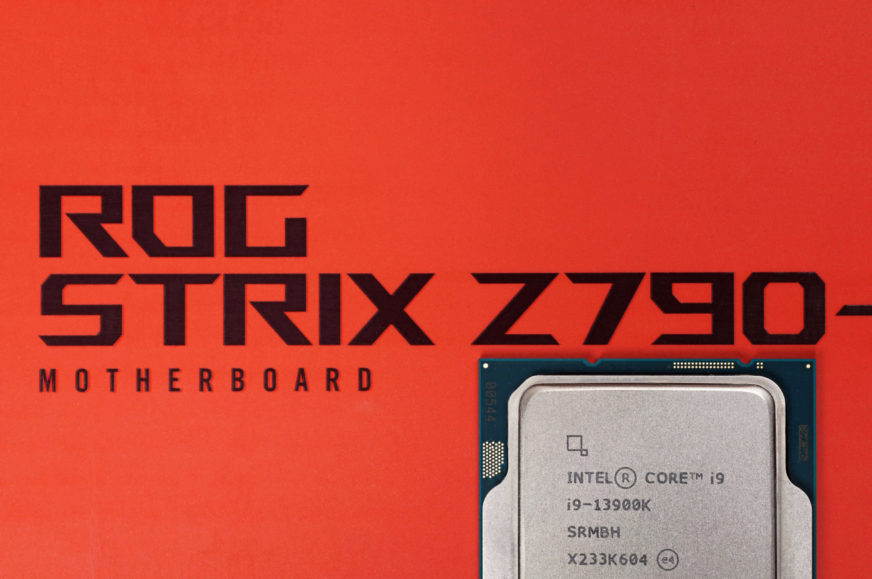Conclusion
New motherboards for Intel Raptor Lake processors are again a bit more expensive in the same class than the previous generation Z690, but they are also better equipped. This also applies to the ROG Strix Z790-E Gaming WiFi, which now has more M.2 slots than SATA ports. What’s also neater is the mechanism for removing graphics cards from underneath the big tower coolers and overclocking the CPU using machine learning. That’s also an option.
Conclusion
There aren’t many reasons to criticize the ROG Strix Z790-E. Some may find the price high, but that’s a general thing – all boards are more expensive than we’d like. Looking at the bigger picture, at all the elements, this board also justifies its price under the current conditions. The “Strix”, of course, is already getting pretty high. First and foremost, the ROG Strix Z790-E has a very robust power delivery, suitable for even the most powerful CPUs. Before you hit the limits of VRM cooling, you’ll be dealing with how to cool the CPU itself. How efficient is the power delivery, that will only become apparent as more motherboards are tested.
All-core boost clock speeds in games are nicely stable, at 5.5 GHz (P cores), or 4.3GHz (E cores). With the “AI overclocking” setting, the situation changes a bit. Some of the “most vital” cores run at higher clock speeds (6 GHz for higher loads is a bit of a utopia even at lower loads that you can cool and are not constrained by power limits), some at lower ones (below 5.5 GHz), and overall there is still a lot of tuning to do with this method of management. Later on, maybe we’ll get to a separate analysis of AI OC versus MCE (MuliCore Enhancement) or manual overclocking, we’ll see.
The BIOS settings are more or less as you know them on Asus boards – very detailed, except for one thing in the fan management (Q-Fan). It too is detailed, with perfect curve adjustment over a wide range of PWM intensities (but also DC, with linear fan supply), but there is one “but”. Namely, it is not possible for a selected fan to adjust its speed according to the temperature on one of the heat sensors other than the one in the CPU, for example according to the VRM one. The board has these, but Q-Fan no longer allows them to be assigned to the curve for the selected fan connectors. On most other boards this is possible, and until recently you could set it up on Asus ones as well. For most users this is a minor thing, but there will always be someone who cares about this type of customization as well. Unlike the Gigabyte Z690 Gaming X DDR4 motherboard, which can work with multiple temperature sensors when tuning the fans, the system connectors also respond to very low PWM intensity. Obviously this is not common, some boards take up from more aggressive values, at which higher fan speeds are achieved.
We did not encounter any performance anomalies. “Gaming performance” in Total War Saga: Troy is admittedly lower, but that’s due to inefficient thread scheduler management, and it’s going to be a similar scenario (at least under Windows 10) on other boards as well. Otherwise, with some bright exceptions (such as the x265 benchmark HWBot), we have performance tests filtered so the processor performs optimally, at full performance, with respect to the needs of a particular application. And the ROG Strix Z790-E doesn’t limit it in any way. The board doesn’t hold back the SSDs either, of which there can be up to five in the M.2 format and all come with full, four-lane support. Four are PCIe 4.0, the first one, with an extra-powerful heatsink is state-of-the-art, with PCIe 5.0 support. And yet there are still four SATA III ports available, which are somehow not mutually exclusive with the M.2 slots, they don’t have shared lanes. This too is an advantage of the better equipped boards with Z790 chipsets. They have more PCIe 4.0 lanes (than the Z690), these are used to connect the M.2 slots, and there are dedicated PCIe 3.0 lanes for the SATA ports.
We’ve already hinted at the very high TDP of the SSD cooler, and we’ll just add that it is, in terms of cooling, ranked first in our tests at the moment. The CPU VRM cooler is also super robust, but not for the sake of keeping up with “weaker” voltage regulators. These are massive, and even at 300 W without a cooler, the hotspots stay below 80°C, which is an excellent result by a wide margin. This is good, for example, for environments with higher ambient temperature (in common practice this is hot summer days) or for systems with less effective system cooling).
Interface speeds for wired network connections, SSD M.2 or external USB ports are always fine and do not deviate from the average. The number of USB ports is also worth praising. Not only on the rear panel, but also internally. One of the changes Asus has made compared to the similar Z690 board is that it has added a second 19-pin to connect two USB 3.2 gen. 1 ports. On some older boards we had complaints about its absence, as on many cases it doesn’t allow you to connect all the USB ports (but only half). This is not the case with the ROG Strix Z790-E.
It will be interesting to see in what light the competing boards show up. The Asus ROG Strix Z790-E is great though, and the “Approved” award is perhaps only temporary. Later, in the final balance sheet, taking into account the features of several boards, we do not exclude the possibility of its promotion.
English translation and edit by Jozef Dudáš
| Asus ROG Strix Z790-E Gaming WiFi |
| + Powerful 19-phase power delivery (VRM)... |
| + ... handles even Core i9-13900K with no power limits without power loss |
| + Option to manually overclock the CPU by changing the multiplier... |
| + ... and "automatic" overclocking options (AI OC, MCE) |
| + Efficient power management |
| + Above-standard performance coolers (both VRM and SSD) |
| + Up to five fast (four-lane) M.2 SSD slots |
| + Eight fast USB 3.2 Gen. 2(×2) connectors on the rear I/O panel |
| + Detailed fan management options |
| + Improved and already perfect Q-release system to unlock the card in the first PCIe ×16 slot |
| - Relatively higher price |
| - For PWM curves, the temperature source cannot be adjusted (everything is tied to the CPU sensor) |
| Approximate retail price: 550 EUR |
Test games are from Jama levova
Special thanks to Blackmagic Design (for licenses for DeNoise AI, Gigapixel AI and Sharpen AI) and Topaz Labs (for licenses for DeNoise AI, Gigapixel AI and Sharpen AI)
- Contents
- Asus ROG Strix Z790-E Gaming WiFi in detail
- What it looks like in the BIOS
- Methodology: Performance tests
- Methodology: How we measure power draw
- Methodology: Temperature and frequency measurements
- Test setup
- 3DMark
- Borderlands 3
- F1 2020
- Metro Exodus
- Shadow of the Tomb Raider
- Total War Saga: Troy
- PCMark and Geekbench
- Web performance
- 3D rendering: Cinebench, Blender, ...
- Video 1/2: Adobe Premiere Pro
- Video 2/2: DaVinci Resolve Studio
- Graphics effects: Adobe After Effects
- Video encoding
- Audio encoding
- Fotky: Adobe Photoshop, Affinity Photo, ...
- (De)compression
- (De)encryption
- Numerical computing
- Simulations
- Memory and cache tests
- M.2 (SSD) slots speed
- USB ports speed
- Ethernet speed
- Power draw without power limits
- Power draw with power limits by Intel
- Achieved CPU clock speed
- CPU temperatures
- VRM temperatures – thermal imaging of Vcore and SOC
- SSD temperatures
- Chipset temperatures (south bridge)
- Conclusion












